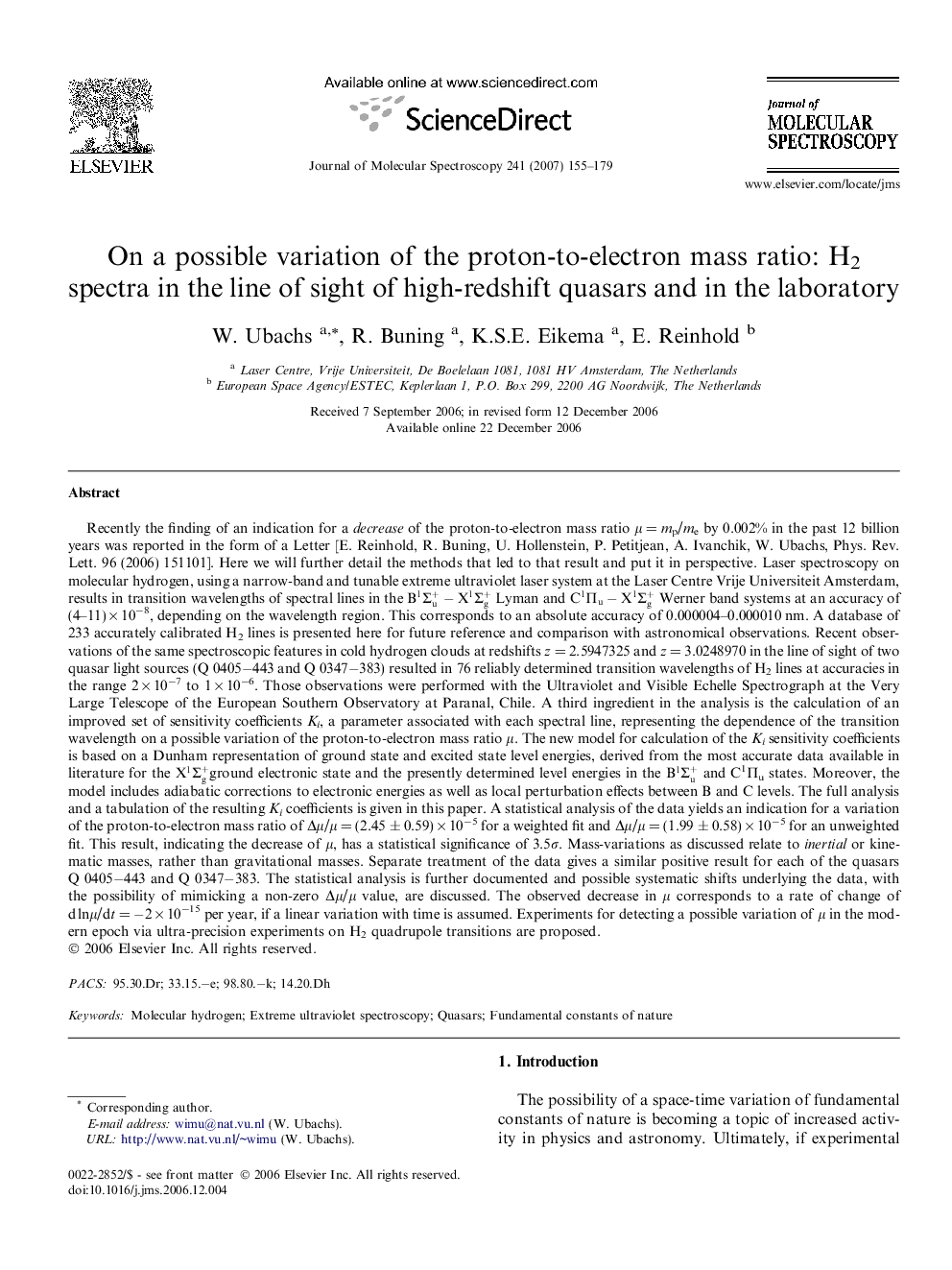| Article ID | Journal | Published Year | Pages | File Type |
|---|---|---|---|---|
| 5415933 | Journal of Molecular Spectroscopy | 2007 | 25 Pages |
Abstract
Recently the finding of an indication for a decrease of the proton-to-electron mass ratio μ = mp/me by 0.002% in the past 12 billion years was reported in the form of a Letter [E. Reinhold, R. Buning, U. Hollenstein, P. Petitjean, A. Ivanchik, W. Ubachs, Phys. Rev. Lett. 96 (2006) 151101]. Here we will further detail the methods that led to that result and put it in perspective. Laser spectroscopy on molecular hydrogen, using a narrow-band and tunable extreme ultraviolet laser system at the Laser Centre Vrije Universiteit Amsterdam, results in transition wavelengths of spectral lines in the B1Σu+-X1Σg+ Lyman and C1Î u-X1Σg+ Werner band systems at an accuracy of (4-11) Ã 10â8, depending on the wavelength region. This corresponds to an absolute accuracy of 0.000004-0.000010 nm. A database of 233 accurately calibrated H2 lines is presented here for future reference and comparison with astronomical observations. Recent observations of the same spectroscopic features in cold hydrogen clouds at redshifts z = 2.5947325 and z = 3.0248970 in the line of sight of two quasar light sources (Q 0405â443 and Q 0347â383) resulted in 76 reliably determined transition wavelengths of H2 lines at accuracies in the range 2 Ã 10â7 to 1 Ã 10â6. Those observations were performed with the Ultraviolet and Visible Echelle Spectrograph at the Very Large Telescope of the European Southern Observatory at Paranal, Chile. A third ingredient in the analysis is the calculation of an improved set of sensitivity coefficients Ki, a parameter associated with each spectral line, representing the dependence of the transition wavelength on a possible variation of the proton-to-electron mass ratio μ. The new model for calculation of the Ki sensitivity coefficients is based on a Dunham representation of ground state and excited state level energies, derived from the most accurate data available in literature for the X1Σg+ground electronic state and the presently determined level energies in the B1Σu+ and C1Î u states. Moreover, the model includes adiabatic corrections to electronic energies as well as local perturbation effects between B and C levels. The full analysis and a tabulation of the resulting Ki coefficients is given in this paper. A statistical analysis of the data yields an indication for a variation of the proton-to-electron mass ratio of Îμ/μ = (2.45 ± 0.59) Ã 10â5 for a weighted fit and Îμ/μ = (1.99 ± 0.58) Ã 10â5 for an unweighted fit. This result, indicating the decrease of μ, has a statistical significance of 3.5Ï. Mass-variations as discussed relate to inertial or kinematic masses, rather than gravitational masses. Separate treatment of the data gives a similar positive result for each of the quasars Q 0405â443 and Q 0347â383. The statistical analysis is further documented and possible systematic shifts underlying the data, with the possibility of mimicking a non-zero Îμ/μ value, are discussed. The observed decrease in μ corresponds to a rate of change of d lnμ/dt = â2 Ã 10â15 per year, if a linear variation with time is assumed. Experiments for detecting a possible variation of μ in the modern epoch via ultra-precision experiments on H2 quadrupole transitions are proposed.
Related Topics
Physical Sciences and Engineering
Chemistry
Physical and Theoretical Chemistry
Authors
W. Ubachs, R. Buning, K.S.E. Eikema, E. Reinhold,
